| کد مقاله | کد نشریه | سال انتشار | مقاله انگلیسی | نسخه تمام متن |
|---|---|---|---|---|
| 1358435 | 981342 | 2015 | 20 صفحه PDF | دانلود رایگان |

To identify potential selective and resistance-breaking mosquitocides against the African malaria vector Anopheles gambiae, we investigated the acetylcholinesterase (AChE) inhibitory and mosquitocidal properties of isoxazol-3-yl dimethylcarbamates (15), and the corresponding 3-oxoisoxazole-2(3H)-dimethylcarboxamide isomers (14). In both series, compounds were found with excellent contact toxicity to wild-type susceptible (G3) strain and multiply resistant (Akron) strain mosquitoes that carry the G119S resistance mutation of AChE. Compounds possessing good to excellent toxicity to Akron strain mosquitoes inhibit the G119S mutant of An. gambiae AChE (AgAChE) with ki values at least 10- to 600-fold higher than that of propoxur, a compound that does not kill Akron mosquitoes at the highest concentration tested. On average, inactivation of WT AgAChE by dimethylcarboxamides 14 was 10–20 fold faster than that of the corresponding isoxazol-3-yl dimethylcarbamates 15. X-ray crystallography of dimethylcarboxamide 14d provided insight into that reactivity, a finding that may explain the inhibitory power of structurally-related inhibitors of hormone-sensitive lipase. Finally, human/An. gambiae AChE inhibition selectivities of these compounds were low, suggesting the need for additional structural modification.
Figure optionsDownload as PowerPoint slide
Journal: Bioorganic & Medicinal Chemistry - Volume 23, Issue 6, 15 March 2015, Pages 1321–1340